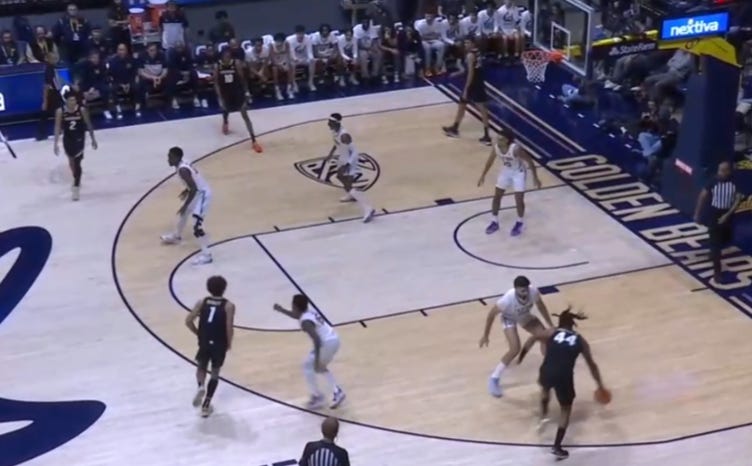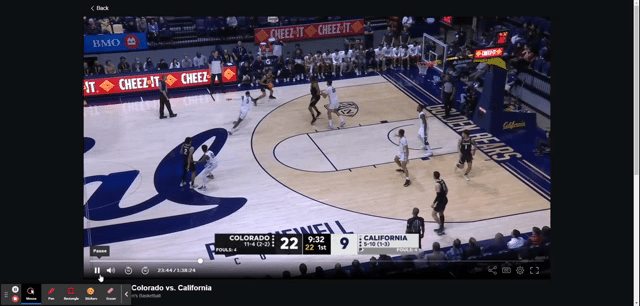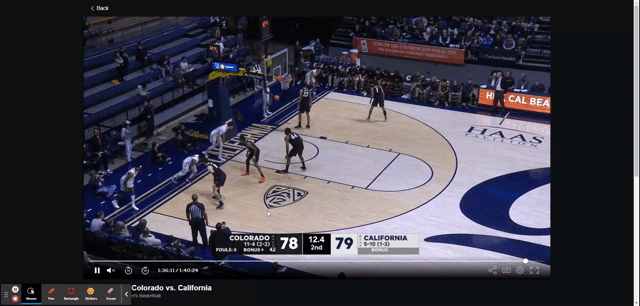Film Room: Cal vs. Colorado Basketball
A few video clips and other observations from Wednesday night
I’m still basking in the glow of Wednesday night’s thrilling come from behind win over the Colorado Buffaloes. While I think the UCLA win will mean more over the arc of the entire season (first conference win, the current Cal/UCLA dynamic, Mick Cronin’s meltdown), the home win over Colorado in such unexpected fashion will definitely be on the recap list for the year. In the postgame press conference, Coach Madsen was asked if this is a “milestone win” for him and the program. His response;
“We are going to have many more wins that are impressive over skilled opponents. This is the start. I know we’re going to hit a pothole or two, but I’ll tell you this; we’re going to fight, fight, fight every step of the way.”
This team truly does fight, fight, fight. At halftime, Cal was down 40-26. I expected the second half would play out similar to the Ole Miss game. Cal would keep playing hard, but Colorado (like Ole Miss) would respond and maintain a 10-point or so lead. Cal would have a run at some point to get it to 6-to-8 points, but in the end Cal could not overcome a large deficit over a quality opponent, and lose by 6-to-10 points. I am glad I was wrong.
Cal’s Defensive Strategy
At Tuesday’s media session, I asked Coach Madsen about team defensive concepts. He emphasized that they are a halfcourt man-to-man defensive team. They may sprinkle in other defenses occasionally, but their bread-and-butter defense is man-to-man.
Cal often plays for trap situations down low. Often it appears as if a player is beaten on a drive, when in reality the defender is playing the angle and forcing the ballhandler into a spot where the trap will be effective. Let’s walk through this using the next clip from early in the first half.
On first watch, it looks like Colorado C Eddie Lampkin beats Aimaq on the drive. This is true, and also not-true at the same time. He does beat Aimaq, but Aimaq directs Lampkin towards where Aimaq wants him to go. Here’s the initial setup.
It’s man-to-man but look at the positioning of Jaylon Tyson near the basket and Keonte Kennedy in the middle. Tyson’s already turned toward the driving Lampkin while keeping an eye on the other potential action in the lane. Aimaq is positioned so that Lampkin cannot go center, but will instead go towards the endline. Tyson quickly slides over.
By Aimaq forcing Lampkin to his right allows the endline to act as a third defender. Now it’s up to the other three defenders to account for the other four Buffaloes. Kennedy has slid down a little, and oriented himself to cover the two wing players. Celestine is also peeking towards the interior.
Cody Williams see the opening and slashes towards the basket. Lampkin makes a good pass.
Keonte Kennedy is connected enough to the play to be able to block Williams’ shot. Celestine is positioning himself for a potential rebound and covering any action involving Tristan da Silva in the corner.
The blocked shot eventually goes out of bounds - turnover to Cal.
When I watch the game in realtime, it sometimes looks like the initial defender is getting beaten. Instead, the player is allowed to drive, but is getting funneled to a specific spot where the double-team happens.
This play above was not executed perfectly. Lampkin made a great pass out of the double team, and Williams was unimpeded in his attacking the lane. But the play is a good example of one of the basic defensive concepts for the Bears. It shows the design on the baseline double-team and the adjustments the other players make when the double-team happens. On Tuesday, coach Madsen said, “Schematically we’re supposed to have high hands so (the player) can’t get the pass through. Sometimes you work the scheme, you work it, you rep it, and sometimes a great player still makes a great play.”
Here’s one where it does not go so well.
Aimaq is waiting for the right time to commit to doubling on Tristan da Silva. Kennedy hasn’t fully sealed off the endline, so Aimaq is hedging against da Silva potentially also going towards the line. Notice as he jumps and tries to seal the top, da Silva is already passing back. If Aimaq commits a second earlier, that pass out to Lampkin would not be so easy. And, it would signal to Grant Newell that Newell needs to be ready to cut off the drive if Lampkin is able to get the pass.
And, one where it goes better.
Jalen Cone and Fardaws Aimaq get Lampkin to stop dribbling along the baseline. Tyson and Kennedy are tracking interior motion, and Tyson does a good job picking up the cutting da Silva. Lampkin passes it all the way back out to reset the offense. After the drive and kickout to Williams, the defense once again collapses on Williams, who draws a questionable foul.
The Play of The Game
The play below was at 2:33 left in the game, tied 70-70. Cone’s made basket gave Cal the lead for good.
There is nothing fancy on this play. It’s good ball movement to get Jalen Cone an open look. What I love about the play is Tyson’s total control of Colorado. He has been driving and dominating, eventually shooting a perfect 8-for-8 for the half, and anticipates the incoming double-team. When J’Vonne Hadley finally commits to the double team, Tyson immediately pulls the ball back out and passes it to Kennedy to rotate it over to Cone. If the double-team doesn’t come, Tyson most likely keeps backing down K.J. Simpson and gets an up-close shot. When the double team comes, he is decisive in initiating the ball movement around to Cone.
Other Observations
Colorado fans capably filled the southwest corner of Haas, and were quite vocal. After the game, a group of drunken fans right in front of press row were yelling “Every year, Tad. EVERY YEAR.” This is the fourth straight loss for the Buffaloes in Haas Pavilion. Cal’s last win last season was at home to the Buffs.
Some creativity on the final inbounds play, modeled after a flanker screen.
Cal returns to action Saturday afternoon, playing the Oregon Ducks in Eugene. The Bears are back home next week for games against Washington and Washington State. The announced attendance for Wednesday’s game was 2,258. The students return to campus, as spring classes start next week. Let’s try to at least double the attendance for next week’s games.












Your knowledge of basketball intricacies is so far beyond mine. I marvel that you can dissect so precisely plays that my limited brain sees only as a mad scramble. I think you are an amazing sportswriter because you try to educate your readers. 💕💙💕thank you for taking the time to do this.
Love these breakdowns and I too noticed how Tyson reacted quickly and decisively to the double
“What I love about the play is Tyson’s total control of Colorado. He has been driving and dominating, eventually shooting a perfect 8-for-8 for the half, and anticipates the incoming double-team. When J’Vonne Hadley finally commits to the double team, Tyson immediately pulls the ball back out and passes it to Kennedy to rotate it over to Cone.“